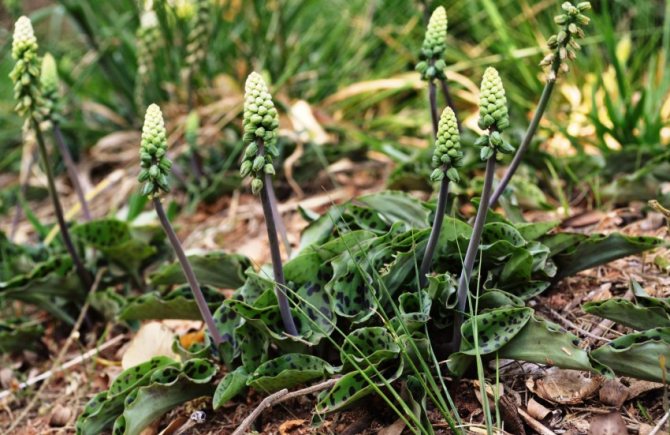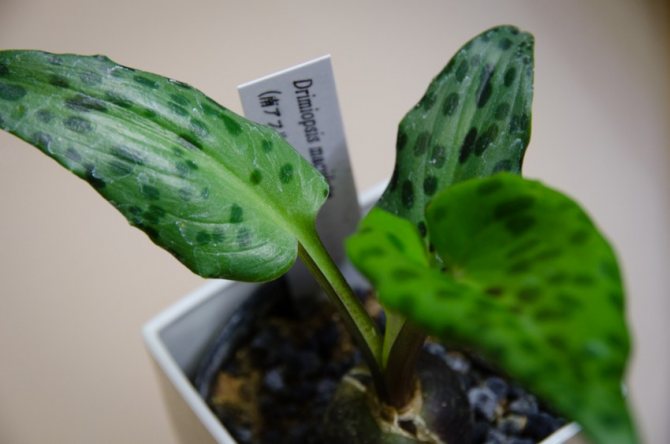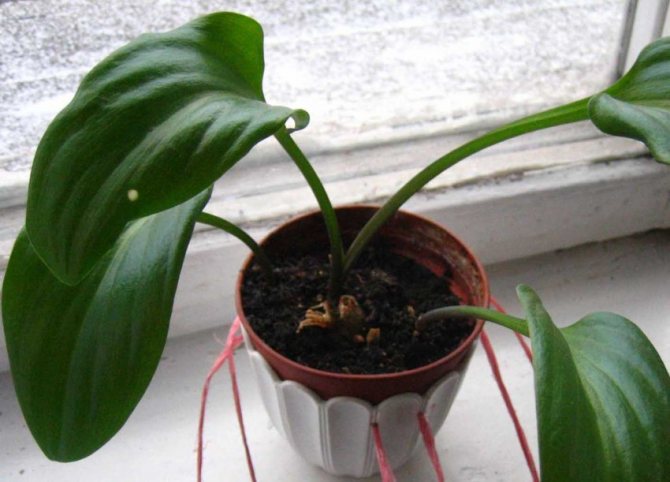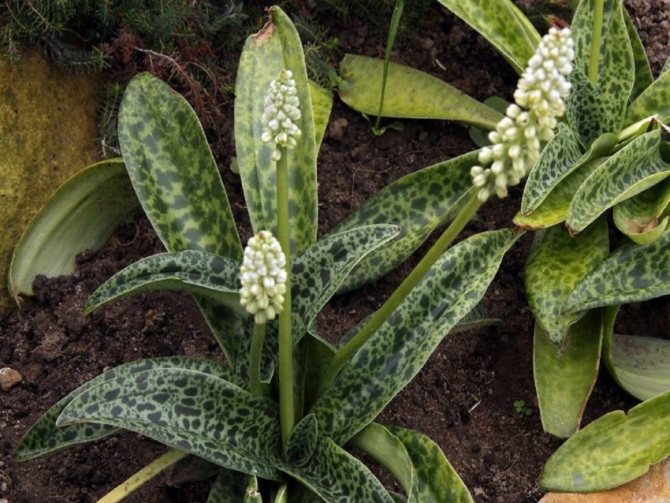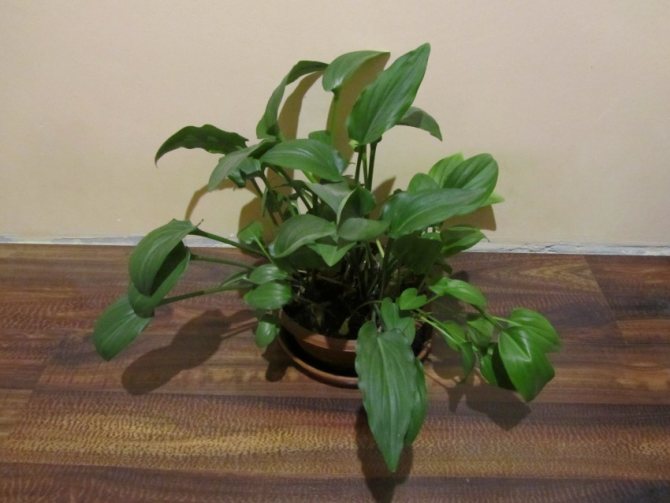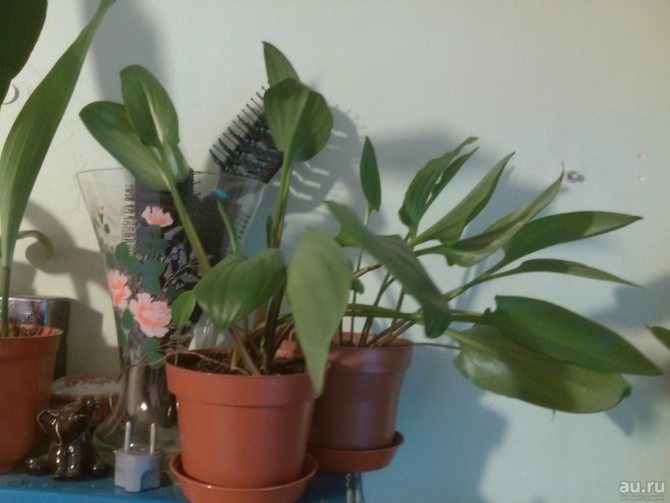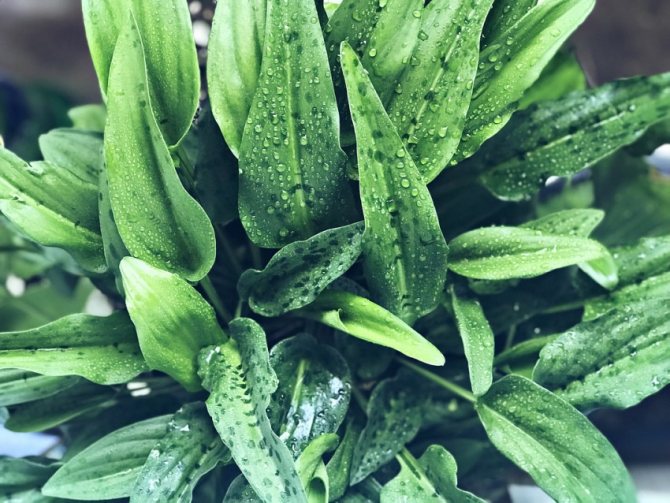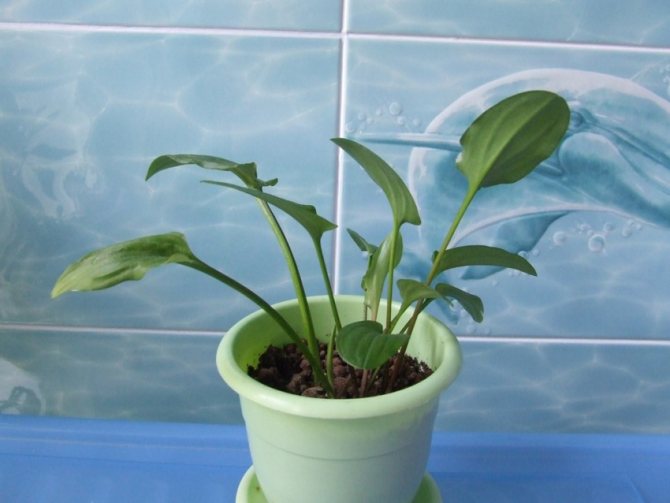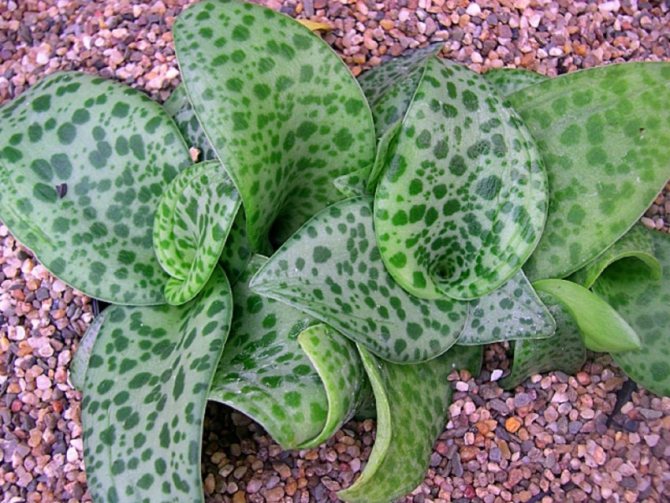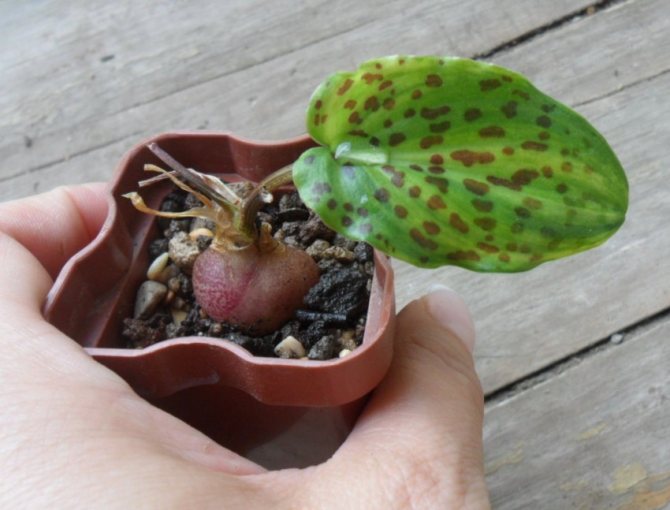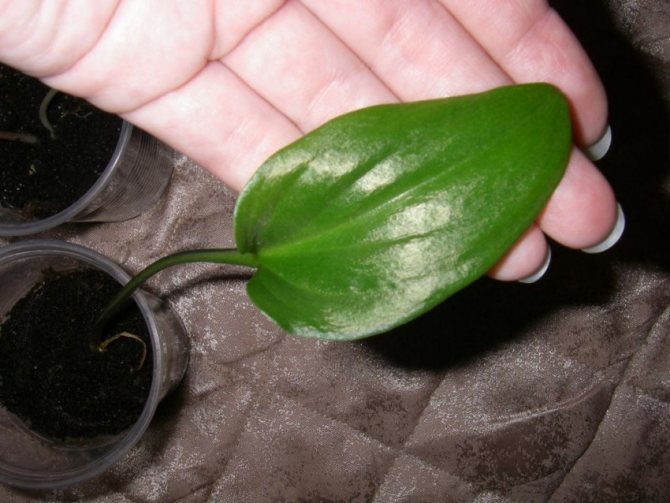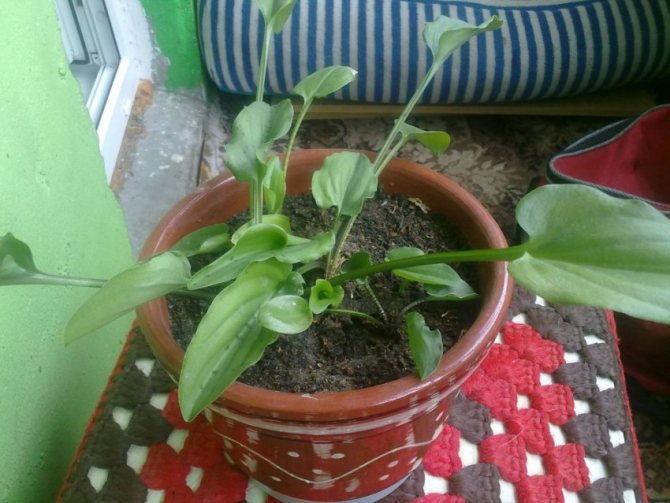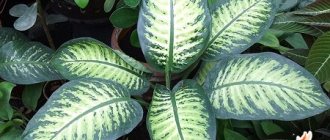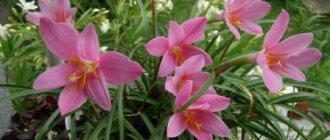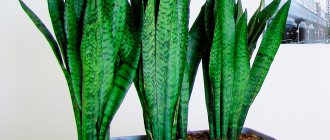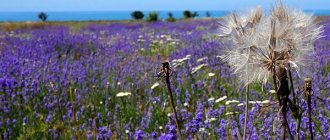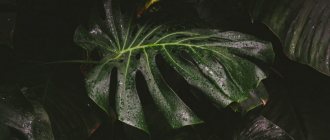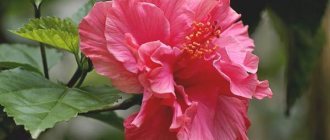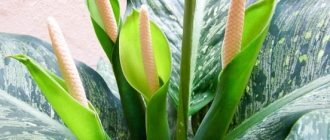Drimiopsis, which is often also called Scylla or Ledeburia, appeared on our windowsills from hot African latitudes. Despite its tropical origin, Drimiopsis is very unpretentious and feels great in the apartment.
In addition to ease of care, it has a lot of other positive qualities. Scylla perfectly refreshes and purifies the air in the room, saturating it with oxygen, decorates any interior, harmoniously fitting into both office and home environments. An additional "bonus" of keeping Ledeburia will be its undoubted mystical talents.
Drimiopsis is an incredibly beautiful plant that pleases all passers-by with lush green bush and colorful flowers.
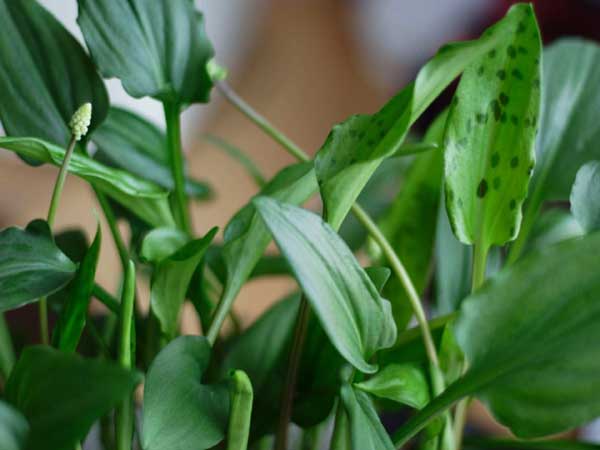
This culture is distinguished by its unpretentiousness and ease of care.
Types of Drimiopsis and their description.
Drimiopis is a representative of perennials., Has oblong leaves, pointed at the end. Leaves are spotty, both dark and light green. In autumn and winter, it gets rid of stains and acquires a uniform leaf color. At this time, he can be confused with Eucharis. Drimiopsis blooms with white flowers collected in an ear.
They can be distinguished by their characteristic flowering for Drimiopsis - white flowers collected in an ear that rises above the leaves on a long shoot. Among the few species of this plant, the most popular are 2 types: Spotted Drimiopsis and Kirk Drimiopsis.
Drimiopsis maculata is a bulbous perennial. This species comes from Tanzania. It has oblong heart-shaped leaves with characteristic spots on them. Has elongated bulbs. The leaves are located on long shoots up to 15 cm in length, collected in a bush. The flowering period is from August to September. The dormant period is from December to February. During this period, it is possible not only to change the color of the leaves to a single color, but also leaf fall. Coming out of the dormant period, Drimiopsis spotted again grows the leaf mass of spotted color.
Drimiopsis Kirkii is a bulbous plant. Originally from East Africa. The bulbs of this type of Drimiopsis are round, white, and not elongated, as in the representative of the previous species. Leaves are lanceolate, fleshy and dense on short petioles, which are often practically invisible. They grow as a bush and form a large, up to 40 centimeters, rosette. The flowering period is from March to September. Flowers are similar to the previous species, but have a slightly pinkish tint. The peduncle itself has a length of 20 to 40 cm. The rest period is not pronounced. Pickaxe, unlike Drimiopsis spotted, does not shed its leaves and does not lose the spotted color of the leaves.
Description of the plant
Refers to the plant to the famous Asparagus family... In the wild, it can be found in the lands of South Africa.
The root system is presented in the form of a bulb, most of which is located above the soil surface. The leaves are large, colorful. The length of the petioles ranges from 8 to 15 cm, and the plates are within 25 cm.


They are all ovoid. The edges of the leaves are smooth, shiny... The surface can be either monochromatic or covered with small inclusions.
Important! If the plant is provided with favorable conditions, then at the end of September, you can see the re-flowering.
How to take care of Drimiopsis at home?
Caring for Drimiopsis is not difficult, the flower itself is very unpretentious, but very unusual, due to which it received a special love of flower growers.
Drimiopsis is not too picky about lighting, it can be placed deep into the room. However, its appearance depends on the lighting. With insufficient light, the leaf spot disappears and its decorative properties are lost. Drimiopsis requires a bright, but diffused light. That is why, the ideal location for him is the south or east window.
Watering Drimiopsis must be done carefully to avoid rotting of the bulbs. The earthen lump should have time to dry out at least 2-3 centimeters in depth. After that, you can water it again. During the growing season and flowering, you need to water Drimiopsis 2 times a week. In the autumn-winter period, watering is reduced, and carried out every 2 weeks, making sure that the earthen lump does not dry out too much. Dry and moist air are equally suitable for Drimiopsis. However, he responds positively to spraying once a week. You can also wipe the leaves with a damp cloth to remove dust.
Not picky about special temperature conditions. In summer, the optimal temperature for it is 20-25 degrees, and in winter it is lower (if possible), but not lower than 15 degrees.
The soil for Drimiopsis is suitable for ordinary bulbous plants. The main requirement is that the soil must be loose. To do this, you can add perlite to the finished soil in a 2: 1 ratio. If you wish, you can prepare the soil yourself. In this case, you will need - sod land, leafy soil, peat and coarse sand. All this must be mixed in a 1: 1: 1: 1 ratio. The container must be chosen rather wide than deep with holes in the bottom.
Fertilization and feeding
During the growing season, which begins from the beginning of spring to autumn, it is necessary to make top dressing with large amounts of calcium, potassium, phosphorus and nitrogen... It is recommended to fertilize the plant twice every 30 days.
An excellent option is the preparation "FlorHumate". There is no need to deposit funds in winter.
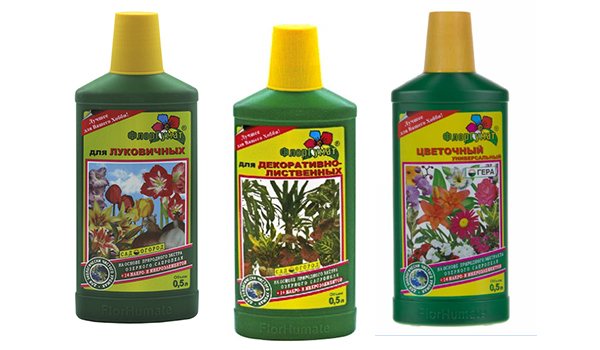

Short description
Drimiopsis, or ledeburgia, is a bulbous plant with spotty light green leaves and small, 10-30 pieces in ears, white flowers. Most of the bulb is visible above the surface of the soil and forms large petiolate leaves (10 to 20 cm), ovoid or heart-shaped, directly from the ground. It is the unusual foliage of this exotic perennial that gives it a charming decorative look and distinguishes it from similar ones. Eucharis,
with which Drimiopsis is very often confused.
Landing
The underground root system of ledeburia is poorly developed, so a deep container for indoor flower cultivation is not needed. Errors relating to planting a perennial in a deep container can lead to decay of the rhizome, as well as slower growth of the aboveground part of the culture.
Drimiopsis will be more correctly planted in a wide container or pot with the obligatory presence of drainage holes. It is more correct to choose ceramic containers.
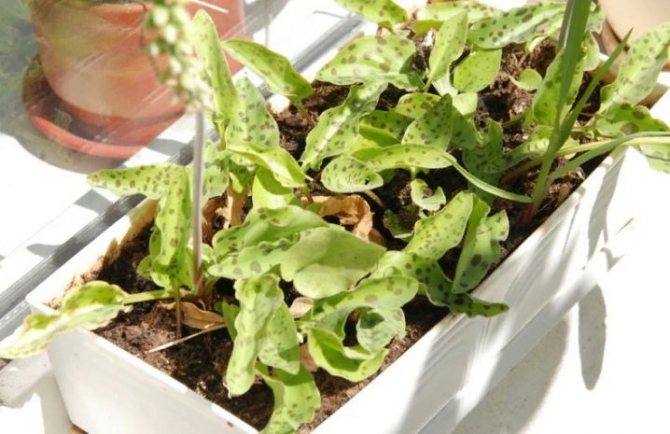

As for the type of soil, the plant will thrive in light and nutritious soil. In garden stores, you can buy a ready-made soil mixture designed for rooting bulbous plants. Its feature will be the ability to retain moisture well inside. To make the soil for the culture looser, peat or sand is sometimes added to it. Drimiopsis also grows well in turf. The acidity of the soil should be neutral. You can make the land for planting a flower yourself. Its composition will be as follows:
- sheet soil;
- sod land;
- humus and coarse sand;
- peat and charcoal.
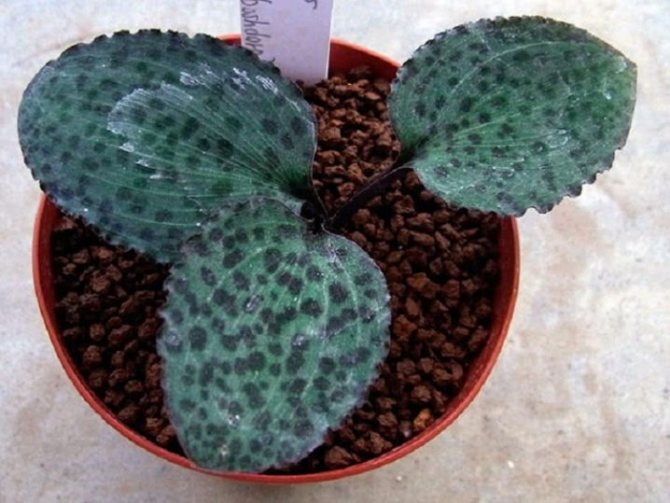

Before rooting a flower, it is inspected for damaged or dry areas that should be removed.
Drainage is laid at the bottom of the pot or container, it is important that it occupies about a third of the container volume. Then earth is poured into the container
The plant is placed in the center, it is important to root the drimiopsis so that the upper part of the root bulb is always located above the soil surface. The soil is compacted by hand, after which the culture should be watered. The next moisturizing can be carried out no earlier than a week later.
Indoor views
The genus of evergreen exotic belongs to the Hyacinth family and has more than 22 species, of which only two representatives of spotted drymiopsis and Kirk's drymiopsis will perfectly take root in the apartment.
Drimiopsis Kirk differs from the previous species with its lanceolate and rather stiff to the touch leaves (40 cm in length and about 5 in width), which have a narrowed shape at the base and a silvery-green tint on the surface of vegetative organs below. Exotic flowering occurs in March-September and pleases the eye with excellent snow-white inflorescences.
Optimal conditions
Although Drimiopsis is a native of the hot countries of Africa, he is quite accustomed to the microclimate of apartments, which is strikingly different from the weather conditions of his historical homeland. When placing a flower in an apartment, it should be borne in mind that it has a habit of pulling shoots towards sunlight. Therefore, so that the plant does not warp, which can lead to a loss of decorative qualities, the pot must be turned around its axis once a week, about a third to a quarter of a turn.
To create optimal living conditions, the following factors should be considered:
Location - sills of windows located on the southwest, southeast and south sides of the house are perfect. In summer, it is useful to take a flower out to a terrace, balcony or loggia.
It is important to protect the plant from cold winds and drafts, while providing it with high-quality ventilation. Lighting - in order for the foliage to appear beautiful patterns of specks, the plant must receive a sufficient amount of sunlight. Drimiopsis is able to withstand even exposure to direct ultraviolet rays, but still diffused light will be more useful, especially in extreme heat
Therefore, in order to avoid burns on the foliage, the flower needs to be slightly shaded, for example, by covering the window with thin tulle or gauze. Temperature - during the active growing season of ledeburg, 20-25 degrees Celsius is required. For a plant that has entered the resting phase, the temperature is lowered to 12-16 degrees above zero. Drimiopsis tolerates heat above 30 degrees Celsius almost without loss, but does not like it very much. Air humidity is not very important for this green bush. With sufficient watering, it transfers dry air quite calmly, especially if there are other indoor flowers nearby. In extreme heat, Drimiopsis can be placed under a warm shower, and also wipe dust from its foliage with a damp soft cloth.
Features of care and conditions for growing
One of the advantages of growing Drimiopsis at home is unpretentiousness in care, but for its proper development and beautiful flowering, it is better to follow some simple rules and recommendations.
It is better to settle Drimiopsis in a brightly lit area, since it adores the sun's rays and, under their influence, manifests its characteristic beauty - the original dark specks on the leaves. A south-facing window is perfect for this.
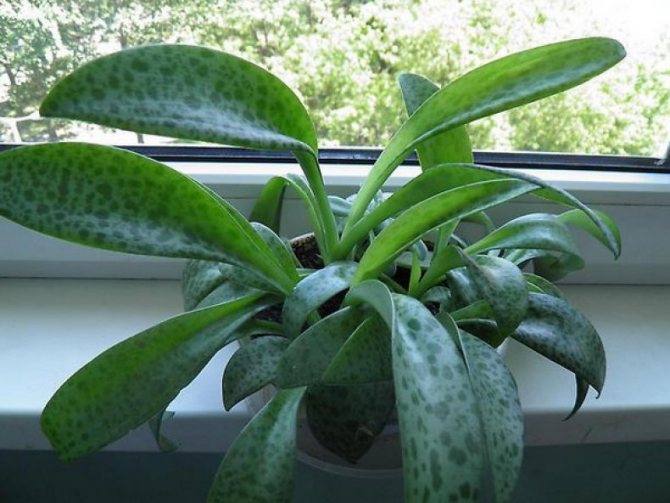

The temperature regime for Drimiopsis is also important, during the spring-autumn period, the thermometer should vary between 20 and 25 ° С, and starting from autumn, it is better to reduce the heat level to 15 ° С.
During the period of active growing season (spring-autumn), watering of exotic plants should be carried out regularly, as the top layer of the soil dries up. At the same time, the water should be settled and sufficiently soft. In autumn, watering should be suspended, and in winter, resumed, but humidification is rare, especially if the bush is in a cool room.
Air humidity for this plant is not particularly important, it easily adapts to life in fairly dry room conditions, but sometimes it will not be superfluous to spray it in hot summer time.
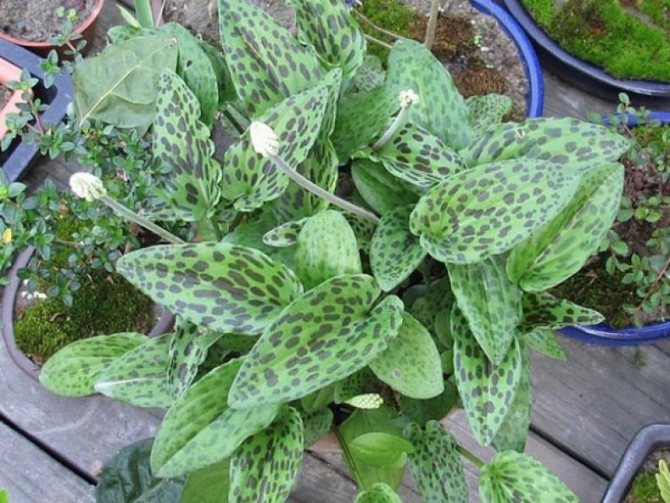

It is required to feed Drimiopsis during the periods of its active growing season, with special fertilizers developed for bulbous bushes. This manipulation should be done every 14 days.
Diseases
Most often, the plant is affected by root rot. It can be determined by the presence of dark scales on the surface of the bulb. Over time they become mucus and start to smell rot.
Important! In order to save the plant, it is necessary to change the soil as soon as possible. All affected areas of the roots are removed, and the sections are processed with a special tool.
Often the plant suffers from stagonosporosis. In this case, small reddish cracks appear on the surface of the bulb. You can get rid of this ailment by reducing watering. and moving the flowerpot to a drier room.


When and how to transplant
It is necessary to transplant a young exotic every year, an adult - about once every 3 years, this will completely depend on the growth of its bulb. To carry out this process, it is imperative to pick up a wide and large container, giving as much space as possible to small new bulbs. Before planting, the selected pot with good drainage at the bottom is filled with a nutritious and loose substrate or pre-purchased bulb soil, which retains moisture perfectly and is as breathable as possible.
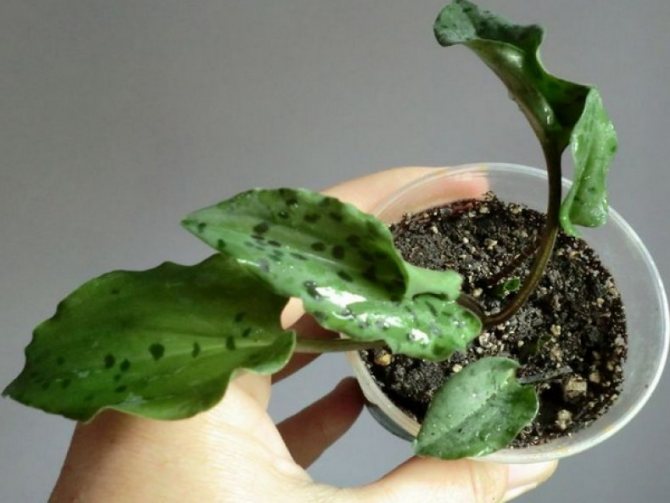

Photo of Drimiopsis
Shallots variety description, photos, cultivation and care photos
Reproduction at home
You should know that it is almost impossible to propagate this tropical plant by seed, since it rarely forms seeds, therefore the division process is carried out mainly by bulbs or leaves.
The leaf method of propagation by cuttings is used, as a rule, in relation to Kirk's drimiopsis. To do this, a leaf of the plant is cut into 6-centimeter pieces and cut into clean sand, at a warm temperature of 22-25 ° C. And after a good fixation of the root system, they are transplanted into containers or pots, with a volume of about 7 cm.
Choosing a place for planting and preparing the soil
When choosing a place for growing ledeburia, it is necessary to give preference to areas with abundant bright diffused light, due to which decorative spots begin to appear on the green mass. On especially hot days, it is better to shade the plant a little from direct sunlight, which will avoid burns. However, it should be borne in mind that with a constant presence in partial shade, the flower loses its decorative functions.
The plant needs soil that is nutritious, light and loose enough.
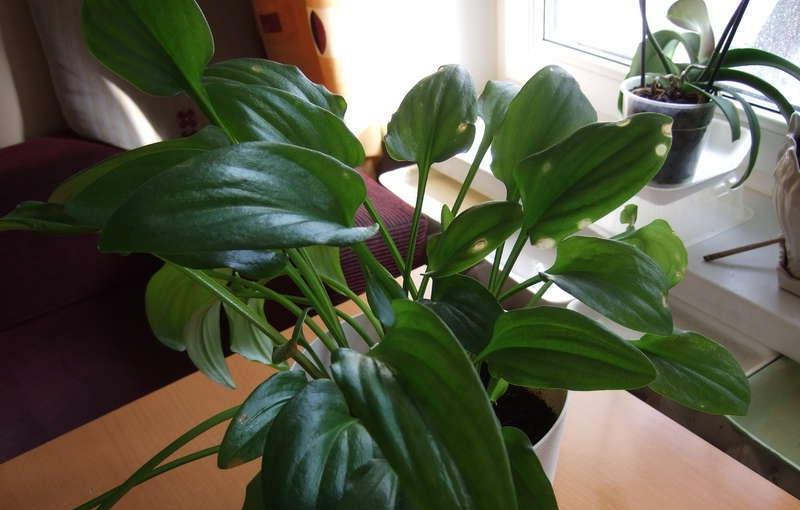

Place for Drimiopsis - partial shade is ideal
Can I keep at home: signs and superstitions
Unfortunately, in the information space, there is no specific information about signs and superstitions related directly to exotic Drimiopsis. But we can recommend it to people born under the zodiacal sign of Pisces, as this unusual bush belonging to the Hyacinth family has a beneficial and calming effect on them, especially when it blooms.
Drimiopsis (Latin Drimiopsis), or Ledeburia, or Scylla is a herb that belongs to the Asparagus family.His homeland is South and East Africa, life expectancy in favorable conditions is more than 10 years.
Video review
Signs and superstitions
- If the dark spots from the leaves of the flower disappeared not in winter, but at another time, it can be assumed that the plant feels the evil eye or damage.
- Drimiopsis is especially beneficial for people born under the sign of Pisces.
- Able to calm the nervous system and help prevent conflict situations.
Drimiopsis is a very hardy plant, capable of forgiving its owner many mistakes in caring for it. But it’s better not to carry out unnecessary experiments and try to follow simple recommendations. In return, the plant will delight you with its bright foliage and almost regular flowering.
Photo gallery
Ledeburia has a beneficial effect on indoor air, refreshing, cleaning, disinfecting and oxygenating it. The plant does not cause allergies, so it can be safely placed in the nursery. It is also absolutely safe for animals.
Care must be taken when transplanting, as the flower bulb can cause severe irritation to the skin of the hands.
Drimiopsis is often mistaken for eucharis. These two plants are very similar and it is possible to determine exactly who is who when drimiopsis blooms. In addition, the leaves of Ledeburia are not as large as those of eucharis.
Care
Verbena flowers description, photo, planting and care
In order for a crop to grow with a beautiful green mass, it needs to be provided with a good level of lighting. Drimiopsis loves bright light, however, in the summer months, the plant on the windowsill is best protected from direct sunlight.
Temperature
The optimal temperature in the room for a perennial will be thermometer readings at the level of + 20-25 degrees in the warm season, in winter it is recommended to lower the air heating to + 15-16 C.
Moisturizing
The indoor flower should be watered as the soil dries up, drought will negatively affect the growth of the culture. However, it is recommended to avoid abundant and frequent moisture, as this can provoke rotting of the bulbs. Those species that enter a dormant phase in winter can be watered every few weeks, but make sure that the soil is not overdried.


Indoor humidity
The plant does not require high humidity, it feels equally good in a humid room and during the heating season, when dry air prevails in apartments and houses. The culture does not need regular spraying, however, it is still recommended to wipe the leaves with a damp cloth from dust.
Top dressing
It is recommended to fertilize the culture. Usually, top dressing is introduced by the root method once or twice a month, starting in spring. Fertilizers containing phosphorus, nitrogen, calcium and potassium will be suitable formulations for Drimiopsis. As a rule, such dressings are used for cacti.
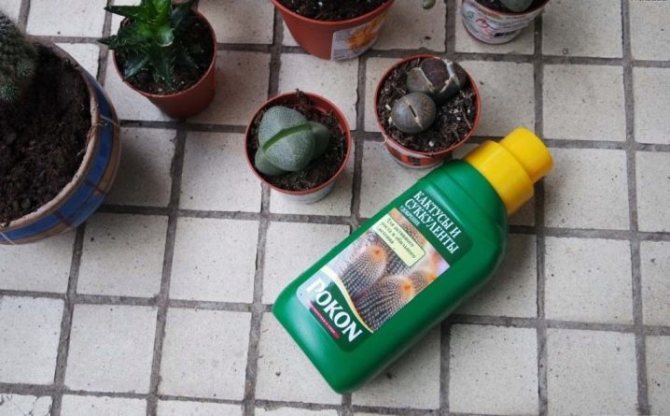

Transfer
The flower requires an annual transplant only at a young age. For adult crops, you can change the capacity and soil once every 2-3 years.
Pruning
In the process of growing a culture at home, it is recommended to remove old leaves from adult plants. This will provoke the growth of new ones.
Winter care
Those species that enter the resting phase in winter require some care. This applies to rare moisture - once every 15–20 days. However, you should not put them in a shaded place. With the arrival of spring, the culture will wake up on its own, at this time new leaves will begin to actively form on it, from which a beautiful and young bush will turn out in just a couple of weeks.
How does it bloom?
Ledeburia has thick, glossy, heart-shaped or oval-shaped leaves with a pointed end and slightly corrugated edges, collected in a basal rosette. The color of the leaves is green, some species have darker spots and dots.The pattern on them becomes noticeable only with sufficient illumination, in the fall it slowly fades and disappears until spring.
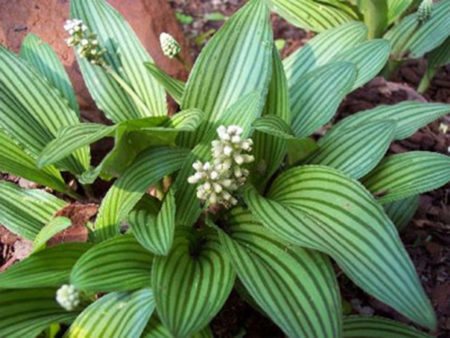

The leaf plate is 15-20 cm long, the elongated petioles are about 10 cm, and the peduncles are 50 cm.In one inflorescence of drimiopsis, from 10 to 30 small (about 5 mm in diameter) flowers are collected, having green-white, gray-pink or cream color and light pleasant aroma. Inflorescences do not bloom all at once, but gradually, so the flowering period lasts 2-3 months.
In its natural environment, Drimiopsis blooms in spring or summer, and at home - all year round, except for the dormant period.
Views
Arrowroot flower, home care, photo
The following perennial species are cultivated at home.
Drimiopsis Kirk (butrioid)
An evergreen crop with lanceolate foliage, the length of which in adult crops can reach half a meter. The flower bulb has a rounded shape and white color, while the leaves at the top are mostly light green with dark blotches, at the bottom the gray tint prevails in the color. The flowering culture occurs from March to September.
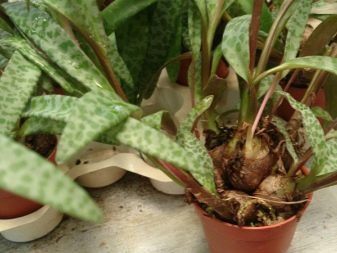

Drimiopsis spotted (petiolate or waste)
A deciduous crop with a heart-shaped foliage. The foliage color is green, there are dark blotches on the surface. The size of the leaves is 10–12 centimeters long, with a width of about 5–7 centimeters. The petioles of the culture are quite large, their sizes vary in the region of 12-15 centimeters. The species blooms from April to July. The flowers are quite small and white. A feature of this culture is the winter dormant phase, during which all the green mass falls off the flower.
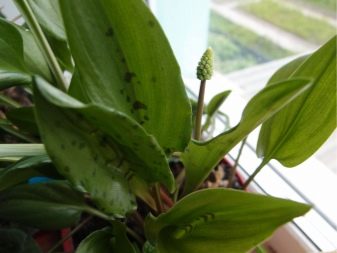

Drimiopsis striped
The species has expressive longitudinal stripes on oblong leaves, for which it received its name. The culture is unpretentious in care, therefore it develops and multiplies well in indoor conditions.


Drimiopsis purple
The leaves of the flower are oval in shape with a wavy and pointed edge in the center of the plate. The color is light green with large blotches of dark color. The petioles of the culture are purple in color.
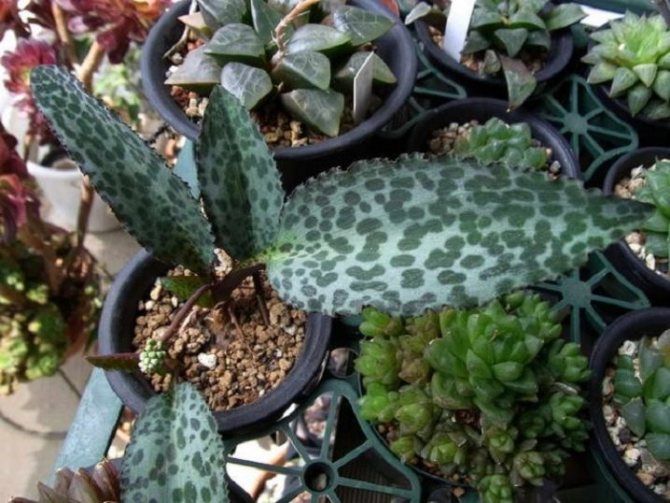

Drimiopsis variegated
Perennial, unusual in appearance, with light longitudinal stripes along the edges of its oblong leaves. Also, a strip may be present in the center. Some crops have yellow leaves.


Drimiopsis dolomiticus
A miniature flower variety with a very unusual appearance, for which it is appreciated by flower growers. The culture does not have petioles, so the leaves grow at the base without a leg, due to which they are very close to the ground. The shell-shaped leaf structure allows the green mass to wrap around the inflorescences, which develop in the center on long peduncles.
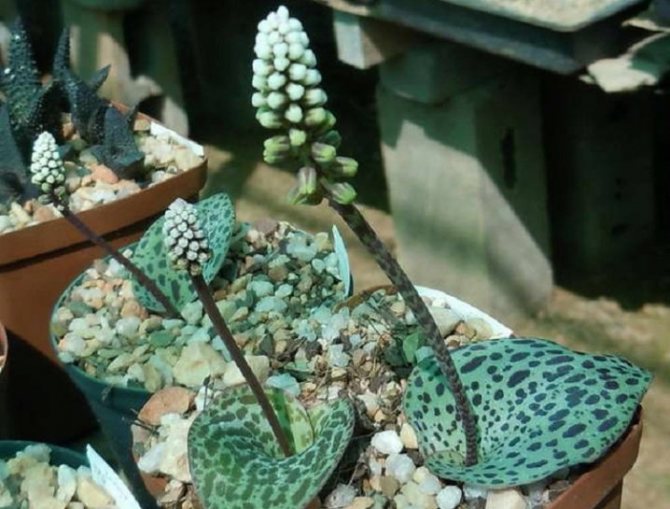

Drimiopsis Burka
A decorative flower with a convex and rather rounded leaf shape. The green mass of the culture is colored gray-blue with dark spots on the surface.


Home care
Comfortable temperature for Drimiopsis in spring and summer is + 20-25 ° C. The plant can withstand + 30-35 ° C, but then it needs to be watered more often and more abundantly. In winter, when the flower has a dormant period, it is better to lower the temperature to +14 ° C, but not lower: if the thermometer drops to +10 ° C, the bulb will die.
If drimiopsis is at elevated air temperatures throughout the year, flowering may not occur or will be short-lived.
The saturation of the color of the leaves and the presence of decorative spots and dots on them depend on it.
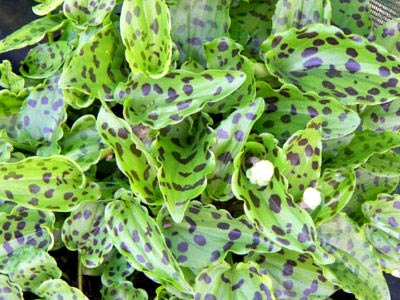

Reproduction
You can get a new culture on your own in several ways.
Seeds
As practice shows, it will be extremely difficult to propagate Drimiopsis by planting seeds, since very little material from the total mass will retain its germination after rooting and will sprout. Planting material can be purchased at the store. The growing process itself is reduced to rooting seeds in a moist and light soil, the pot is covered with a film or a plastic bottle
Keep the seeds warm, the air temperature in the room should not be lower than +22 C, it is important to provide the seeds with a sufficient level of lighting
Good material will hatch 2-3 weeks after planting. As soon as the first shoots appear, the covering material can be removed from the container.
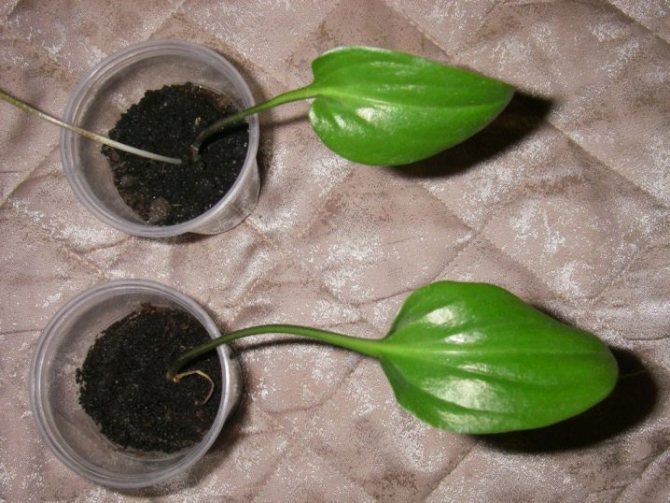

Separation of bulbs
This option is considered to be simpler and more productive. This is due to the peculiarities of Drimiopsis for active growth. The process itself involves the extraction of the plant from the soil, after which the flower should carefully separate a young bulb or several, which will have their own roots. Cutting points must be disinfected with crushed charcoal.
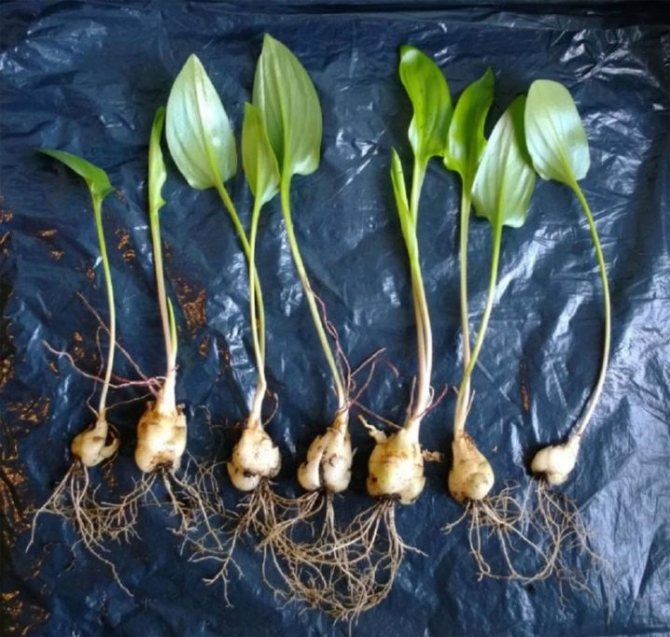

Cuttings
Drimiopsis Kirk can be propagated using a sheet. To do this, the selected specimen is separated from the plant at the very base, after which it is kept in water for several days. Further, it is transplanted into a container with earth, providing a temperature regime at +23 C.


What kind of pot does a plant need?
Due to the fact that the root system of ledeburia is poorly developed and children are reluctant to form, a deep volumetric container for planting should not be chosen, this will increase the risk of rotting of the bulbs and suspend the growth of the ground part of the plant.
It is best to choose a wide, flat pot that has drainage holes to keep the bulbs from rotting. Of the materials, it is desirable to use natural ceramics because of its ability to pass air, but perlite, vermiculite, fine gravel or expanded clay are also suitable.
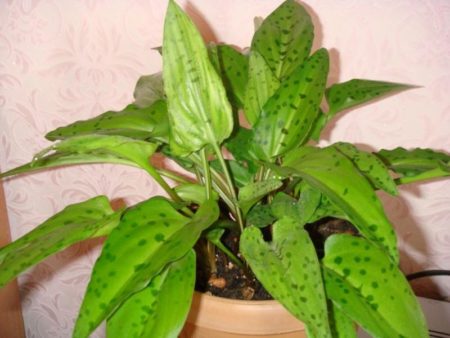

You can buy Drimiopsis in flower shops or order online, the cost varies from 280 to 700 rubles.
After purchase, you need to quarantine it for 2-3 weeks. You should not immediately put it in the sun - it is necessary to gradually accustom the plant to proper lighting.
Diseases and pests
Errors related to plant care can provoke a culture disease. Most often, excessive watering provokes the development of fungus on the bulbs, which can lead to the processes of decay of the rhizome, as well as the appearance of a red burn. If even the slightest signs of an illness appear on the perennial, the culture must be removed from the pot, and then all areas damaged by spores must be removed with a disinfected sharp instrument.
Further, the plant should be kept for some time in a store-bought antifungal composition. For these purposes, it is recommended to use "Trichodermin" or "Glyocladin". It is impossible to root a flower in the same substrate, since there is a risk of re-infection.


Also, a lack of sunlight can provoke a deterioration in the condition of the plant. In this case, the leaves lose their color, and the petioles become too long. To save the culture, it must be rearranged to a more illuminated place in the room.
As for pests, the following insects can pose a danger to Drimiopsis:
- spider mite;
- scabbards;
- aphid;
- mealybug.
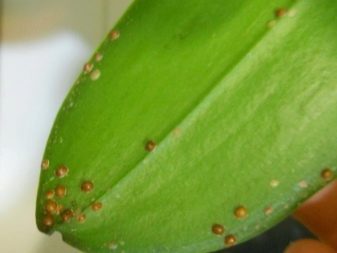

The latter type of insect is quite easy to detect, since the products of its vital activity are a waxy coating on the leaves of the plant, as well as the substrate extending from the walls of the pot. For the destruction of individuals, an alcohol solution is used with which the green mass is processed. Also, the pest can be exterminated with the help of store tools. Among them it is worth highlighting "Tanrek" or "Mosplan".
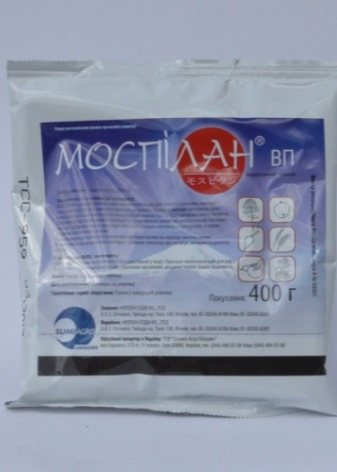

Aphids can be destroyed by spraying the culture with a decoction of pungent-smelling herbs. Store-bought compositions for the fight against this insect are "Aktara" and "Inta-Vira".


The shield affects the color of the soil in the pot - it turns black. The pest itself is not as small as the aphid, so it can be seen on the plant. On foliage, the insect will look like a gray-brown bump. The fight against the scabbard is carried out in several stages. First, the pest is removed from the culture by hand, using a cotton swab dipped in alcohol. After that, the flower should have a warm soapy shower. When the culture is dry, it is treated with Metaphos or Fufanon.
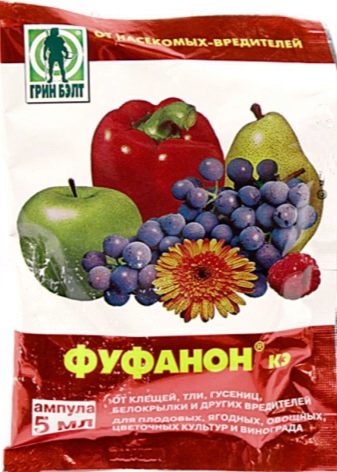

Mites can appear on the plant due to low air humidity.Signs of the presence of insects on the flower will be yellow spots on the green mass and cobwebs. You can destroy the pest by treating the culture with a soapy composition under the shower, after which the Drimiopsis must be covered with polyethylene to create a humid microclimate inside. Among the chemical compositions for combating spider mites can be identified "Fitoverm" or "Akarin".


How to propagate Drimiopsis correctly, see the video below.
What kind of soil is needed?
Drimiopsis requires a loose, nutritious soil that can retain moisture and allow air to pass through well, and has a near-neutral acidity.
You can buy ready-made soil for bulbous plants. To make the soil looser, sand or peat with perlite is added to it.
You can make an earth mixture yourself, for this you need:
There are several ways to treat the soil from pests:
The optimal time for transplanting is early or mid-spring.
Drimiopsis under the age of 3 years are transplanted annually, each time increasing the diameter of the flowerpot by 2-3 cm, bulbs that are 3-5 years old - every 2 years, then every 3-4 years. Cases when a transplant is needed:
Transplant stages:


The next watering can be done only after 7 days, then continue care as usual.
Pests
Shield
You can determine the presence of this pest by the color of the soil. The ground turns black, and the plant is covered with growths of a brown hue. In this case, the flower is sprayed with Metaphos.
Spider mite
All leaves are covered with cobwebs, and small dark dots appear on the inside. Delete spider mite is easy... To do this, it is enough to treat the plant with soapy water.
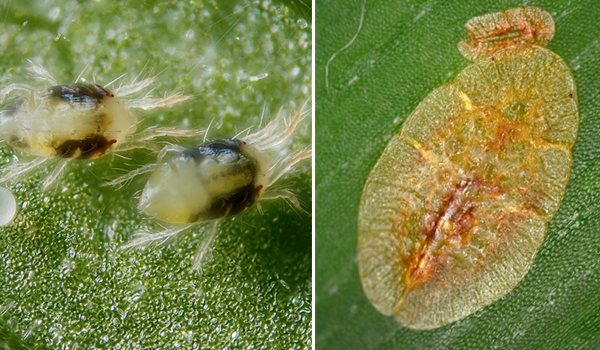

Mealybug
The insect appears in the form of small lumps that have a dirty color. In this case, the leaves are wiped abundantly with alcohol. They carry out such procedure every 14 days, until complete disappearance worm.
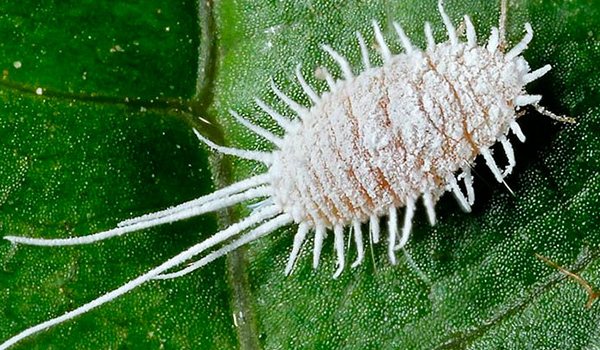

Drimiopsis has not only beautiful appearance, but also useful properties. It is popularly used to treat a number of diseases. Therefore, in order not only to transform your apartment, but also to become the owner of a storehouse of vitamins, you will need just follow the simple rules of care.
Baby bulbs
The planting material is separated from the mother plant after a wintering period during the flower transplantation process.
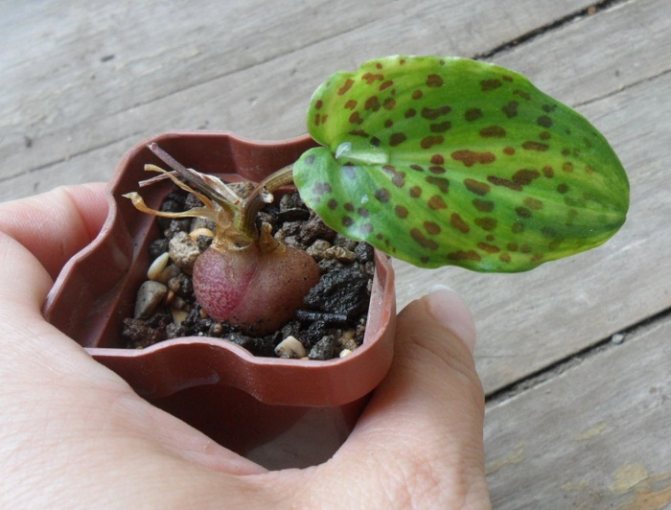

Drimiopsis propagation by bulbs
Bulb propagation includes the following algorithm of actions:
- the bulbs must be separated with minimal damage (the existing cuts must be treated with charcoal, brilliant green, iodine, cinnamon, colloidal sulfur or crushed chalk);
- Fill small pots with a mixture of coarse sand, leafy soil and fertile turf in a ratio of 1: 1: 2;
- moisten the soil;
- provide all the necessary conditions (bright diffused light, air temperature at least 25 degrees, lower heating is desirable, no greenhouse is needed);
- the soil mixture must be moistened once every 2-3 days;
- rooting will occur in 2-3 weeks, when the roots grow up to 3-4 cm in length, young specimens can be transplanted into a standard soil for Drimiopsis.
Microclimate
Many lovers of home flowers note the durability and unpretentiousness of the plant in question, however, for good development and flowering, the rules for its placement and keeping conditions should be observed.
Important! Although the plant is safe for humans, the juice of the bulb can irritate the skin. It is not for nothing that, translated from Greek, "drimiopsis" means "sharp", so it is better to carry out all work on transplanting and cultivating a flower with gloves.
Location and lighting
Unlike some indoor flowers, Drimiopsis is very fond of the sun, including direct sunlight, so it is better to settle it on a well-lit window facing south. A young or recently acquired flower should be accustomed to the sun gradually, shading it with a light curtain.It is better to do the same on too hot days so that Drimiopsis does not burn the leaves.
Temperature and humidity
The comfortable temperature for Drimiopsis is + 20–25 ° С, in the cold season the flower prefers a cooler temperature around + 14–15 ° С. The plant is completely unassailable to the humidity of the atmosphere and can grow in any room, even with dry air.
However, in a too hot period, it is better to spray its leaves periodically, which will also help fight dust.


Name
The main name of the flower (drimiopsis) in translation from Greek means "like drimi". If you take a closer look, the similarity of the culture with the sea bow becomes obvious. The second (ledeburia) comes from the name of the researcher of African flora K.F. von Ledebourg.
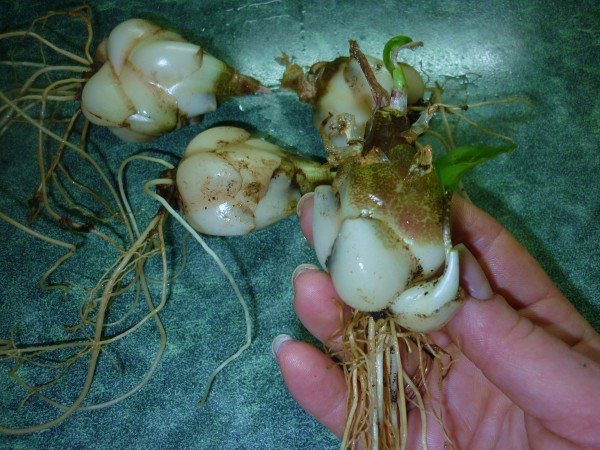

Drimiopsis bulbs
The naturalist is also known for having created the first school of floristry in the Russian Empire, and was appointed director of the first botanical garden.
The third name (scilla) is now practically not used, while it is very often found in thematic books of the 19th century.
Transfer
Young bulbs are transplanted every year into a pot 2 cm larger than the previous one. Five-year-old Drimiopsis needs a procedure as the bulbs grow.
The process itself is simple:
- The bottom of the pot is covered with a drainage substrate (expanded clay, small pebbles or broken brick).
- Pour on top and lightly press down on new soil.
- The total thickness of the two layers should be about half the height of the pot.
- The plant is removed from the old container, inspected for rot. Dry scales and spoiled roots are removed, and the cuts are sprinkled with charcoal powder.
- Separate the daughter bulbs from the mother plant if necessary.
- Make a depression in the ground, install a plant in it. Top up the soil so that the top half of the onion remains outside.
- Water the transplanted flower and put it in its usual place. In the future, care should be taken as usual.
More about plant transplant:
Pests and diseases
With a high resistance of Drimiopsis to pests, it can still be affected by the scale insect and spider mite. If there is a danger of infection, soap or alcohol spraying (50% solution) will serve as a good prophylaxis. If the infection has already occurred, you will have to buy insecticides (for example, Bankol or Actellic). Most of them have a pungent odor, this question should be checked with the seller or sprayed outdoors. As for diseases, in the absolute majority they are caused by errors in the care of Drimiopsis.
The plant is very attractive to cats. They can inflict great damage on him - jump on him, break, gnaw on stems and leaves. If there are cats in the house, you need to take care of the inaccessibility of the flower.
Biological description
Ledeburia is a perennial blooming almost all year round, at first classified as a member of the Lily family. Subsequently, its status was revised and assigned to the Asparagus. The inflorescence is white, sometimes with beige, greenish and yellow shades, collected from 20-30 buds in a brush or ear. It has a small bulb, usually no more than 2 cm in diameter, which can have an almost superficial location and is prone to overgrowth and formation of extensive clumps. The leaves are leathery, elongated, with a variegated color - green spots or stripes on a silvery background. In the lower part, they are most often monochromatic.
Are Drimiopsis, Ledeburia, Scylla the same?
A frequent case in biology when the same plant was discovered and described in completely different places, but practically at the same time. At the same time, he was given different names, which subsequently led to classification confusion. This flower culture has two official names - Ledeburia and Drimiopsis. There is also a third - Scylla, but it can rather be attributed to the folk, although in the 50-60s.of the last century, it was ubiquitous in biological reference books and textbooks. All three names can be considered synonymous, and minor distinctive features should be attributed to varietal characteristics.


Drimiopsis propagation by bulbs
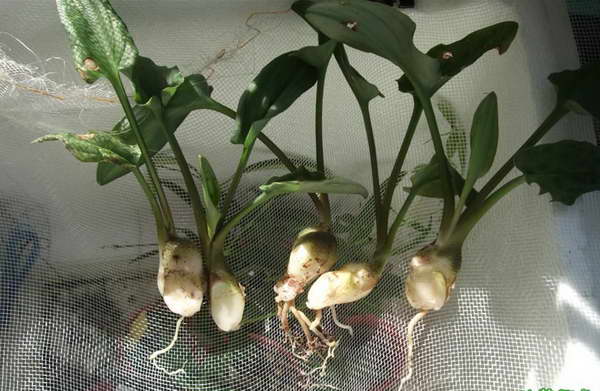

Young bulbs of drymiopsis - excellent planting material photo
- It is most convenient to propagate the plant with bulbs.
- After a dormant period, remove them from the pot, divide them and divide them into separate pots.
- If the bulb is damaged during separation, it is necessary to disinfect the damaged area with a fungicide solution and dry it a little.
Reproduction methods
Drimiopsis reproduces by vegetative and seed methods. Growing Drimiopsis from seeds is a rather troublesome task. It is complicated by the fact that collecting seeds is not easy and they very quickly lose their germination. However, it is possible to sow the seeds in light, moist soil. Cover the surface of the pot with foil. The container must be placed in a warm (+ 22 ... + 25 ° C) and bright room. Seedlings appear within 1-3 weeks. After germination, the shelter is removed from the greenhouse and watered regularly. Seedlings quickly grow green mass.
A much easier method of propagation is to separate the young bulbs. Drimiopsis grows very quickly and can double in size in just a year. Dig up the plant completely and carefully separate the bulbs. It is important to preserve the thin roots, and sprinkle the damaged areas with crushed charcoal. Young bulbs are planted singly or in small groups, taking into account that the plant will soon grow again.
Drimiopsis Kirk can also be propagated by cuttings. Adult, strong leaves are cut at the base and rooted. You can put the leaf in water for several days or immediately plant it in wet sandy soil. During the rooting period, it is important to maintain a temperature of + 22 ° C. After the appearance of independent roots, the cuttings are planted in small pots in light, fertile soil.
Drimiopsis: botanical description
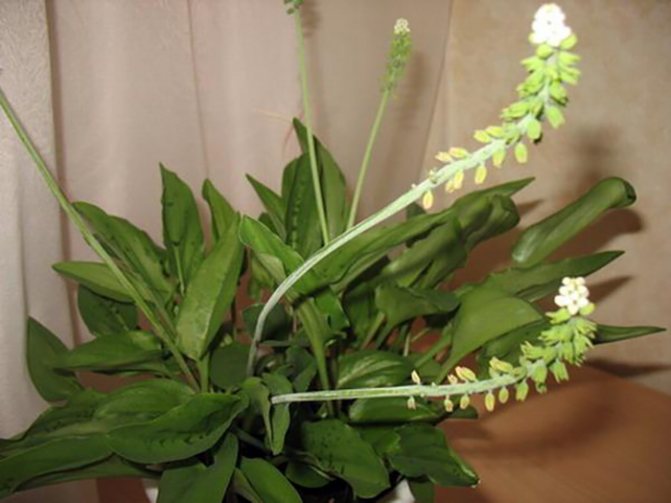

Of course, all of the above does not mean that this flower can be looked after carelessly. Yes, he steadfastly endures the oversights of the grower, but if you take care of him properly, Drimiopsis will look quite decorative!
Indoor drymiopsis is a separate genus from the hyacinth subfamily, the asparagus family. It got its name due to the fact that the juice of its bulbs can greatly irritate the skin of the hands. This was noticed by the ancient Greeks, and they called it "sharp", which sounds exactly like "drimiopsis".
The homeland of the plant is the tropics of Africa, as well as the island archipelago of Zanzibar. Very often in floriculture, Drimiopsis is confused with the Ledeburia plant, considering these words to be synonyms. But although Ledeburia is indeed similar to Drimiopsis (especially to some of its species), these are different flowers belonging to different genera.
Drimiopsis are bulbous perennials. There are about 20 species in the genus, sometimes significantly differing in appearance. However, there are similarities.
The leaves are dark green, often spotted, elongated, in some species rather stiff. Usually there are no more than 4 leaves in a rosette, growing on short petioles.
The bract forms a kind of spike, consisting of several dozen very small flowers with a pleasant, distinct smell. (By the way, if you look at the flowering Drimiopsis and Ledeburia, you can immediately see their differences).
Air humidity
The houseplant Drimiopsis perfectly tolerates a dry and humid climate, so it is not necessary to carry out additional humidification of the air to maintain its growth and flower formation during the flowering period.


Spraying the leaf plates is rather a hygienic procedure, because it helps to rid the plants from the possible dust accumulated on them, such events will help stimulate the development of the flower and extend the flowering period in the period that is usual for it.
Features of seasonal care
In spring and summer, Drimiopsis has an active growth. During this period, he needs good lighting, regular feeding, moderate watering. In the fall, the plant prepares for rest. Spotted drymiopsis partially sheds the leaves, and the remaining ones become monochromatic. Drimiopsis Kirka stays with leaves for the winter. All species for the winter need to properly organize a dormant period. Reduce the air temperature to + 13..14 ° С. From October, gradually reduce watering to 1 time in 2 weeks. The colder it is in the room, the less often you need to water the plant. Stop feeding completely. Leave the lighting at the same level.
With the onset of spring, Drimiopsis begins to wake up on its own. With the first warm days, young arrows appear, on which leaves bloom. And in a couple of weeks a small bush will already form.
Varieties
In nature, there are 22 varieties of Drimiopsis, however, only 14 of them are registered. Almost all of them are common only in the natural environment. At home, only two types of Drimiopsis are cultivated.
Drimiopsis spotted. Distributed in the vicinity of Tanzania. It forms compact bushes 25-35 cm high. The oval leaves are 15 cm long. They are attached to long (up to 20 cm) petioles. Their surface is colored light green and densely covered with darker spots. In the bright sun, the motley color becomes even more noticeable, and in the shade it can completely disappear. This variety blooms in mid-April - July. At this time, long, often curved arrows appear with a dense panicle of snow-white, cream or yellow flowers. When the flowers wither, the plant goes into a dormant state and almost completely gets rid of the leaves. The leaves gradually dry out.
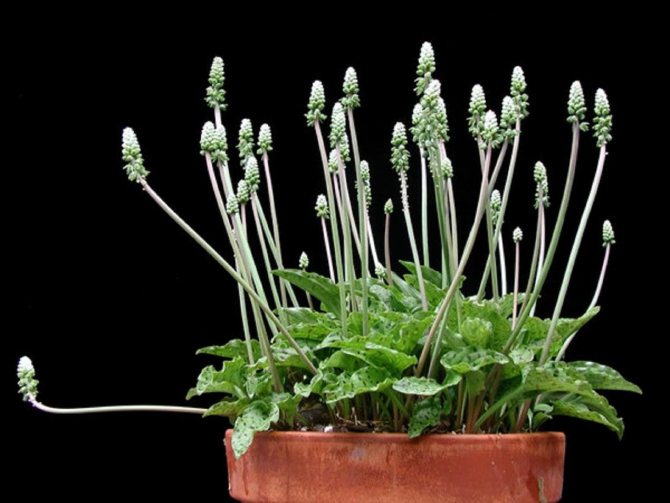

Drimiopsis Kirk more common near Zanzibar and Kenya. It forms a larger, spreading bush up to 50 cm in height. The leaves are located on shortened petioles and have a leathery, monochromatic surface. Sometimes a small amount of dark speck is visible on the foliage. The shape of the leaf plate is oval or heart-shaped, with a strongly elongated, pointed edge. The length of the leaf is about 35 cm, with a width of 5 cm. Embossed veins are visible along the entire surface of the leaves. From March to September, flower stalks 20-40 cm long are formed, which are densely covered with buds on top. The variety is considered evergreen and does not get rid of the foliage during the dormant period, it only stops the formation of new shoots.
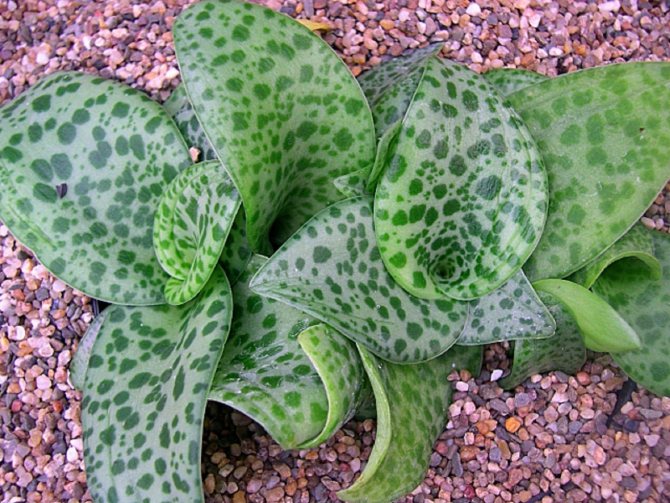

Temperature regime
While maintaining the usual temperature for the plant, the leaves of Drimiopsis remain bright and green throughout the year, the leaf plate average in area does not lose its elasticity even after the spikelets have flowered.
- How to care for tomatoes - planting, watering, feeding and the main nuances of growing. Tips and secrets of tomato care for beginners (110 photos and videos)


Feeding tomato and cucumbers with yeast: recipes and video instructions on how to properly feed vegetables with yeast (105 photos)
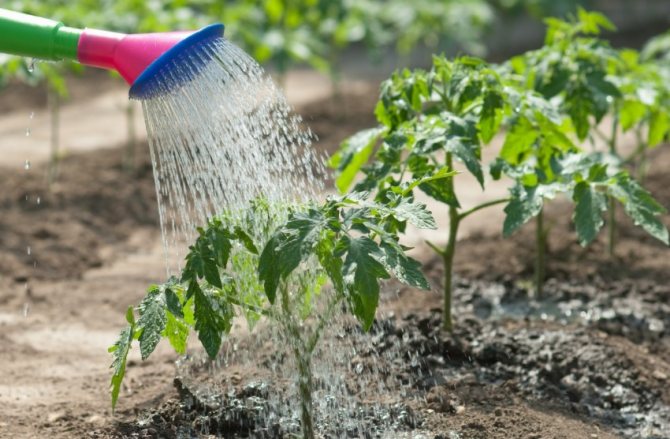

Boric acid for tomatoes: methods of application as fertilizer for the garden and vegetable garden. Expert advice and detailed technology for the application of boric acid to tomatoes (90 photos + video)
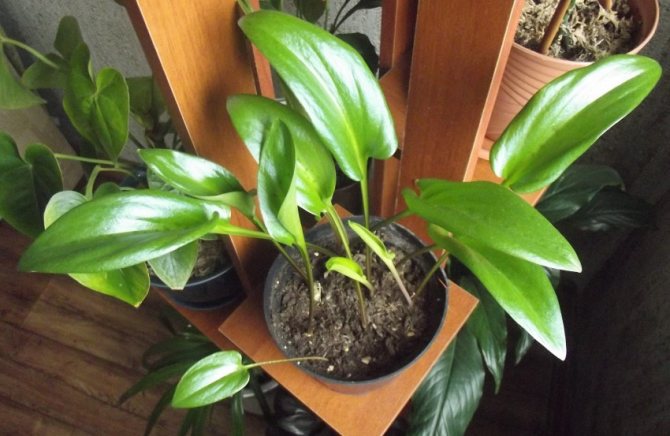

In the summer, it grows well at a temperature of 20 to 25 degrees Celsius, and in winter it is better to lower the temperature regime to +14, it is recommended to bring plants planted outdoors into the house and provide them with good care and watering in an apartment.
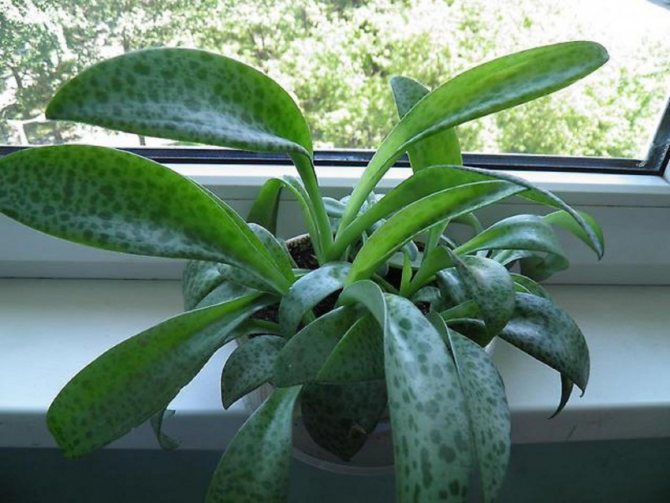

Growing problems
When growing ledeburia, flower growers without experience often face problems. The main ones and how to solve them are described below:
| Problem | Reasons and solutions |
| Blackening of the petioles. | It occurs against the background of excess moisture in the soil and gradual decay of the bulbs. To help the plant, you will need to transplant it into new soil as soon as possible. Rotten parts of the bulb are cut off. |
| Pulling out the petioles, blanching of the foliage shade. | The problem is most often caused by a lack of light. Containers with flowers should be transferred to a bright area as soon as possible. In some cases, it is advisable to apply additional lighting with a fluorescent lamp. |
| The green mass withers. | The problem arises against the background of insufficient soil moisture. It is important to adjust the frequency of watering. |
| The appearance of brown or black spots on the tips of the foliage. | It occurs due to an excess of moisture in the soil. The damaged leaf plate should be cut off immediately and the flowers treated with Hom. |
By cuttings
Namely, leafy cuttings (suitable only for Kirk's Drimiopsis). The sheet plate is cut into two parts. The length of each of them should be 5-6 cm. Reproduction with whole leaf plates is also allowed. They are separated at the base of the bulb along with the petiole (so that it has a white base), and then rooted in a peat mixture with the addition of sand or in clean water (in the future, it will have to be changed once every 2-3 days).
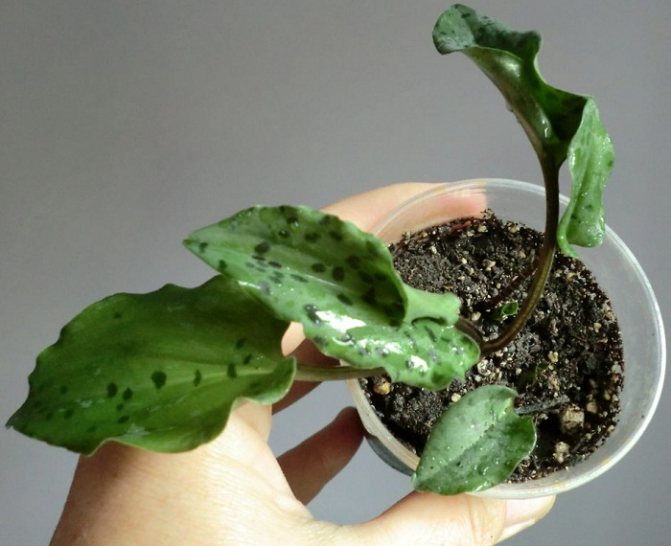

Propagation of Drimiopsis by leaf cuttings
Containers with cuttings should be tightly covered with polyethylene or placed in a mini-greenhouse. The air temperature should be at least 22 degrees in the presence of bottom heating. Once every few days, the substrate should be sprayed with water, and the "greenhouse" should be ventilated daily for 3-4 minutes. The roots will appear in about a month, from that moment it is necessary to wait about 10 more days, and then transplant the cuttings into separate containers with a diameter of 7 cm.The pots are pre-filled with a mixture of sand, leafy and sod land in a ratio of 1: 1: 1. The last stage is transplanting the plant into a substrate for adult specimens.
Leaves for propagation should be chosen absolutely healthy, whole, not affected by pests, completely retaining their shape and color.
Important nuances of flower care
Drimiopsis successfully refutes the opinion that growing tropical plants at home is possible only if the grower devotes the lion's share of time and energy to them. This flower pleasantly surprises with its unpretentiousness and endurance.
Watering
From mid-spring (when the transplanted bulbs give the first shoots) and until the end of September, the plant is watered as soon as the substrate dries out 3-4 cm in depth. If the weather outside is moderately warm, once every 5-7 days is enough. Water is poured around the edges of the pot, being careful not to drip onto the bulbs.
Water for irrigation should be soft, warmed to room temperature. The ideal option is melt or rain.
If there is no alternative, filter, boil, or stand tap water. Citric acid or apple cider vinegar will help get rid of harmful impurities - compounds of calcium, fluorine, chlorine will give a precipitate in the form of white-gray flakes.
Drimiopsis often does not like dry soil in a pot, it may start to turn yellow, but it still tolerates "drought" much easier than waterlogging. Constant over-abundant watering is one of the few ways to guarantee the destruction of the plant.
Fertilization
The plant needs feeding only during the active growing season. It is enough to water Drimiopsis once every 12-15 days with a solution of liquid complex fertilizer for bulbous plants. Also suitable for feeding cacti and succulents. The solution is prepared according to the instructions.
You should not neglect completely feeding Drimiopsis - the plant needs nutritious soil
Winter is a dormant period
During the dormant period, the plant either completely sheds its foliage, or simply stops growing. From the beginning of October, watering is reduced, gradually increasing to once every 10-15 days. The cooler it is in the room, the less often you need to water the flower. But it is also impossible to let the earthen coma dry out to such a state that the soil moves away from the edges of the pot.
Drimiopsis requirements do not change regarding illumination. It can be left on the south window without even shading, because the winter sun is less active. Top dressing is not applied.
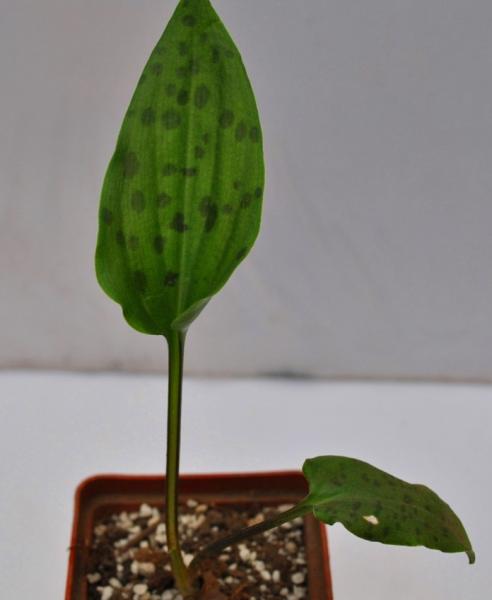

If drimiopsis looks like this in mid or late autumn, it is completely normal.
Video: how to care for Drimiopsis
Where to put?
A suitable place is the sill of a window facing south, southwest or southeast. In the summertime, it easily transfers life on the balcony, veranda, terrace.


The main thing is not to allow cold drafts, but you cannot leave the plant without periodic ventilation.
Poisonous or not?
Contrary to popular belief, Drimiopsis is not poisonous. Moreover, there were no cases of allergy to it in humans or animals. At the same time, its bulb contains juice, which can cause a burning sensation when it comes into contact with the skin, and the plant itself was named because of its resemblance to the sea onion drymia and is translated as "sharp". It is better to work with him with gloves. Drimiopsis has no contraindications to growing at home. On the contrary, like all indoor plants, it has the beneficial property of purifying the air and releasing oxygen.
Rotate the plant pot about 1/3 turn once a week for a nice, even crown.
Content during dormancy
Like the vast majority of bulbs, Drimiopsis will want to get some rest during the winter months. In late autumn, its leaves lose their blotchiness, gradually turn yellow, and soon completely or partially fall off. At this time, you need to smoothly reduce watering, lower the temperature. If possible, protect the sleeping flower pot from the dry and warm air of the apartment.
Important! Pay particular attention to the temperature of the earthball. It is often very overcooled in winter, especially if the window frame has cracks. It would be nice to set the pot on a stand made of foam, or made of wood, screened from the window. In cold, damp earth, the bulb will begin to ache.
They begin to take the flower out of dormancy somewhere in mid-February, from the beginning of March. Watering is increased, the temperature is increased.
Diseases, pests and difficulties in caring for drimiopsis
From excessive watering or staying in a cold, damp room, rot and fungal diseases can appear. When the first symptoms of plant infection are detected, the earthen lump must be dried, the air temperature must be brought to the optimal mode. Remove the affected parts of the plant, treat the plant with a fungicide.
The plant can be attacked by spider mites and scale insects. Rinse the Drimiopsis under a warm shower, dampen a cotton pad with soapy water and wipe the leaves of the plant. Treat with insecticides if necessary.
Why do the leaves of Drimiopsis turn yellow
Drimiopsis leaves turn yellow what to do photo
- If the leaves of a plant stretch out, lose their spotting, fade - this is a consequence of insufficient lighting. Place the Drimiopsis pot in a bright, diffused spot.
- Yellowing and leaf fall occurs from over-watering - do it in moderation.
- The lower leaves turn yellow and die off: Drimiopsis lacks nutrients and moisture. Perhaps a transplant is required: the land is already poor, hardened from frequent watering and neither moisture nor nutrients are supplied to the roots.
Watering and soil
Active growth and flowering require mandatory and regular watering, which must be carried out to maintain a normal level of soil moisture, avoiding stagnant water, which is eliminated by arranging drainage.
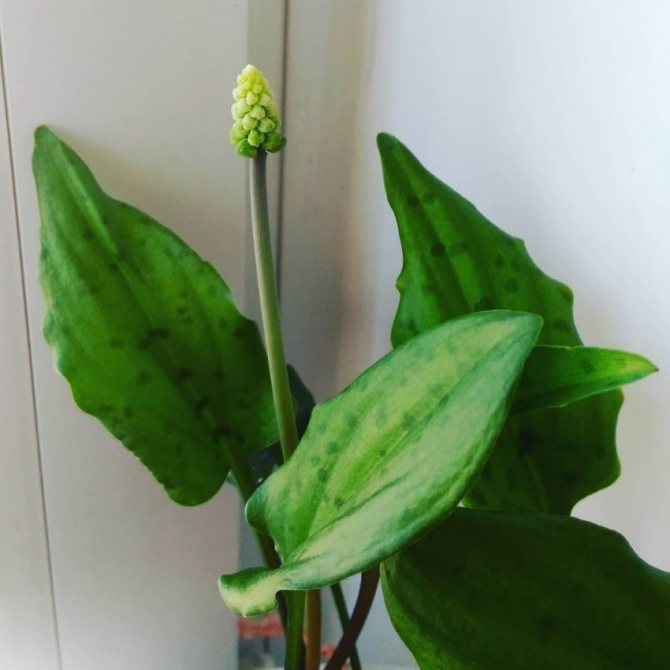

In autumn and winter, the flower begins the wintering period, during stagnation, watering can be significantly reduced by loosening the soil, it is better to use ready-made soil for bulbous plants to root the plant, which will ensure the normal growth of Dreamopsis.


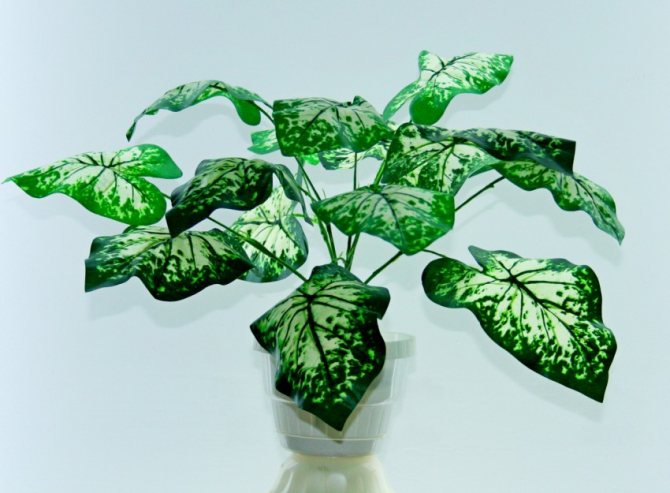

Dieffenbachia - home care tips. How to properly maintain and use a plant in interior design (125 photos and videos)

Fitosporin for tomatoes: methods, processing methods, video instructions and 105 photos of the result of application
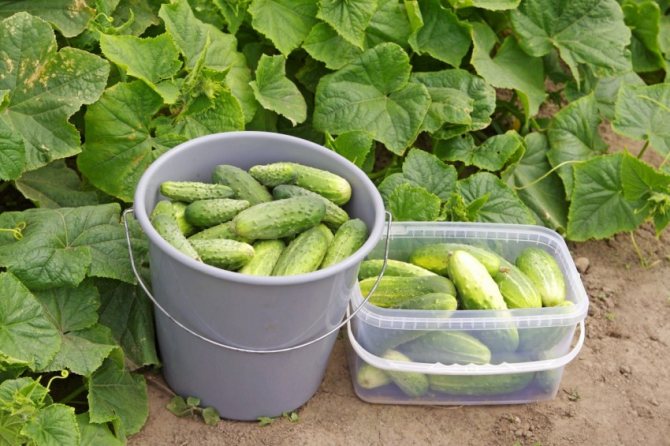

Feeding cucumbers: 110 photos of the best products. Video advice from experts when, what and how best to fertilize and feed cucumbers during growth



